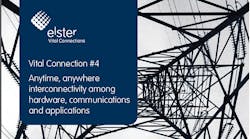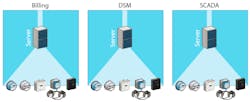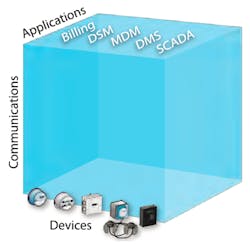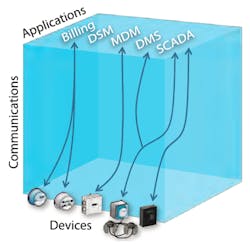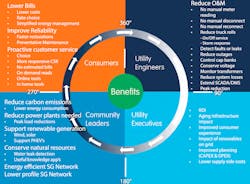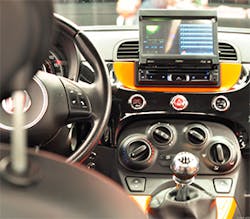2D Interoperability – A Story of Proficiency
Over the last several decades, communications systems were generally designed and implemented to perform a narrowly defined set of tasks or applications. Though very effective in their assigned roles, they were quite limited in their ability to grow and add value in other areas. Thus, as the advantages of existing solutions and the case for automating additional tasks became clear, utilities were compelled to deploy a distinct system for each new application. The result? Today, utilities often have separate communications solutions in place for residential automated meter reading (AMR), commercial and industrial AMR, advanced metering infrastructure (AMI), supervisory control and data acquisition (SCADA) and work force management (WFM) – not to mention individual demand-side management systems (DSM), distribution management systems (DMS), and more – all of which need to work together to maximize business benefits.
To date, this has been made possible by connecting devices, communications and software to provide multiple but separate system solutions. We call this 2D interoperability, as depicted in the dimensional model below. And there’s no denying that utilities have become very proficient at it.
3D Interoperability – A Story of Promise
In a September 2009 paper, the Gridwise Architecture Council (GAC) defined interoperability as the "capability of systems or units to provide and receive services and information between each other, and to use the services and information exchanged to operate effectively together in predictable ways without significant user intervention."The paper goes on to say that a planned study would be based on results in other industries, saying "examining the financial and related benefits from peer industries presents a possible model for the electricity network of the future where information becomes interactive across heterogeneous systems and decision-making becomes distributed."
This implied need for system-wide interoperability across the smart grid is a leap forward that will require a different mental model; one Elster describes as 3D interoperability. Extending beyond the GAC definition to include peer-to- peer communications and the sharing of network infrastructure across devices and applications, 3D interoperability encompasses vertical, horizontal and deep interoperability.
Figure 3 – Previously disparate applications now become part of a single network architecture that shares infrastructure including communications and cyber-security. The model also includes peer-to-peer level communications.
What exactly does vertical, horizontal and in-depth interoperability mean for utilities? The 3D model aspires to a full three dimensions of freedom – in other words, technology can move along any axis without disrupting existing technology along other axes. This assures technology transparency across the solution set to support ongoing convenience, cost and appeal. Moreover, it eliminates the rippling upgrade costs commonly associated with past 2D implementations, thereby promising much lower system maintenance costs.
Beyond the financial benefits (aptly discussed in the GAC paper), the overarching advantages to 3D interoperability accrue across a broader stakeholder footprint than those afforded by the 2D model. Why? Previous system approaches using the 2D model were localized, with benefits to stakeholders as constrained as the architecture itself. For example, AMR systems and some AMI solutions have traditionally been deployed with little regard for outage management systems (OMS). However, with a 3D approach that interfaces the meters and the communications directly to the OMS, near real time power status of each homeowner can be conveyed using the same infrastructure.
And that’s not all. Moving to three dimensional interoperability will bring myriad benefits to major stakeholders, as outlined in Elster’s 360 Degree Solution Model chart below.
Figure 4 – The 360 Degree Solution Model showing the major stakeholders and benefits of a future smart grid system utilizing the 3D interoperability model.
Of course, to reap these rewards, it’s important to recognize the significance of the underlying infrastructure. For many of the applications, knowledge is critical – even perishable. If accurate data is not received, understood and acted upon in a timely manner it may be useless or greatly diminished in value. At a technology level, certain network bandwidth and latency performance will be necessary. At a cyber-security level, effective protection will be essential.
From the Meter and Beyond
3D interoperability is important at all levels on the smart grid infrastructure. At the meter level, this requires smart meters that take emerging standards and technology into account and which result in interoperable devices capable of supporting any RF mesh radio technology as well as other technologies, including Ethernet. This will enable utilities to install smart meters today that can be read using legacy processes but which can later be programmed to run the next generation of RF mesh and other AMI network choices. The meter should be capable of being upgraded to meet the standards that evolve from organizations like the IEEE Smart Utility Network’s (SUN) Task Group 4g. The goal of SUN is to provide a global standard that facilitates very large scale process control applications capable of supporting large, geographically diverse networks with minimal infrastructure, with potentially millions of fixed endpoints. Elster’s REXUniversal® meter was designed with such 3D interoperability in mind.
Across the globe, today’s electricity networks are part of our vital global infrastructure. In the United States, many of these networks are tied together and cover wide swaths of our population. It’s through a broadened vision and conceptual thinking that we can take the next step together. By considering all of our stakeholders early in the design process and creatively applying advancing technology, we can achieve 3D interoperability to deliver the 360 degree solutions of tomorrow.
About the Author
Pat Corrigan is Vice President, Public Utilities for Elster Solutions. In this capacity, Pat is responsible for Elster Solution’s public-owned utility and member-owned utility market and sales strategy, including channel management. Pat has extensive background working in the utility industry to improve business processes, develop marketing strategy, develop IT solutions, and manage products and markets. He consults regularly with executives from a variety of fields to help create synergistic solutions for public power customers.
Speaking the Same Language: What cars and the power grid have in common
By: Doug Lambert
MultiSpeak Program Manager, National Rural Electric Cooperative Association
Let’s compare the 3D interoperability model to the operation and maintenance of the modern automobile. When repairing a car, parts can be duplicated and replaced with newer parts thanks to the existence of national industry standards. From the very basics of the socket to the threads on the bolts, standards allow this car to be evaluated and worked on by practically any mechanic equipped to serve that model. Not only do the basic physical components of the car comply with standards, so do the on-board computers and sensors built into modern vehicles. Over the past few decades, these high-tech communications systems have helped transform cars from bulky gas-guzzling behemoths to sleek, high-performance technological wonders, more efficient, comfortable and safer than ever before in history.
Within today’s car, computers interact with one another and with sensors located throughout the vehicle (the 3D interoperability model) as well as with the driver (the operator). By listening to all of the inputs from these various sources, including air pressure, air temperature, throttle position and oxygen, to name a few, the on-board computer ensures reliable, consistent operation without compromising any of the components’ original functions and intentions.
With the addition of each device, communications network path and application, the 3D interoperability model becomes more complicated as information exchanges increase. The key to the success of all of these computers and sensors "speaking"to one another clearly, reliably and consistently is the real-time exchange of information in a standard format. In order to maintain overall performance, the existence of data communications standards is just as important as the standards for any of the other parts of the car.
In an automobile, each device, application and system was designed and engineered to accomplish specific tasks. When those systems exchange information to other systems, they must all speak the same language or the performance of that operation fails, which typically leads to the failure of other operations. This ability of these high-tech components to all speak the same language ensures that the message is always received in the same manner.
When you depress the accelerator in the car, you have certain expectations that the car will go. How that information is transmitted to the on-board computer and to the other systems needed to make that happen are irrelevant to the driver as long as the expectations are met. The exchange of computer data through standards has been developed and applied throughout the electric utilities industry in its use of communications systems to run the power grid and in-house operations.
One such interoperability standard is MultiSpeak®. MultiSpeak serves to meet the expectations among systems offered throughout the utility market, allowing a wide variety of products to speak to and understand one another. Utility operators shouldn’t have to worry about how information will be exchanged among its communications systems. Just like the driver of a car, an engineer or IT professional should be able to simply apply a standard like MultiSpeak to connected devices and software and get the desired results without worrying about performance or system failure.
Streamlining Outage Management: A Case in Point for 3D Interoperability
By: Steven E. Collier
Vice President of Business Development
Milsoft Utility Solutions
Consider the automated outage management system (OMS) as an example of the importance of full 3D integration/interoperability. An OMS is a collection of hardware, telecom and information systems and applications that enable electric utility employees to better detect, evaluate and manage utility responses to customer power outages. Multiple systems and applications from diverse vendors enable the OMS. All these systems must of course interoperate seamlessly for an efficient management of power outages.
A customer information system (CIS) provides information about customers affected by an outage, including contact information, geographic location coordinates, critical life medical support systems, disconnection for an unpaid bill, and so on. The CIS can be part of a more comprehensive enterprise resource planning (ERP) solution that includes fixed and mobile work and workforce management that can be used to mobilize utility employees. The mobile work force management may be augmented with automatic vehicle location (AVL). The CIS must allow access from the OMS and other systems. It is always advisable to use standardized protocols for these application protocol interfaces (API). The vendors of these systems must publish their APIs and these interfaces must be thoroughly tested.
A geographic information system (GIS) can be used not only to identify and display what utility assets are affected, but also display where affected customers are located and connected to the network. It may include mobile applications that enable field crew navigation, facilities inspection, damage assessment and restoration logistics. Again, standard APIs make this exchange of data much more efficient and application integration much simpler.
Engineering analysis (EA) software can help establish the location/cause of a power outage and be used to evaluate sectionalizing and switching schemes, accelerating repair and restoration. The underlying detailed circuit model can be used to more accurately and quickly identify all customers affected by an outage. Of course this is another example of the need for standardized APIs.
In addition to a utility’s telephone system, employee and customer communications may include interactive voice response (IVR), remote call centers, email, text messaging, social media, web portals and mobile apps, all helping to ensure adequate, effective communications with all stakeholders. Once again, application interfaces must be tested.
A supervisory control and data acquisition (SCADA) system can provide real-time data including power on/off, voltage and current. Smart meters, including some legacy AMR/AMI systems, can provide similar information to help determine who has lost power (and who has power restored). A utility can "ping"smart meters in the vicinity of a reported outage to speed determination of the extent and cause of an outage. This is where the outage is first identified so the interfaces and end-to-end integration starts here and ends at the enterprise applications described above.
OMS is a mission critical application that must operate dynamically in real time. There is neither time nor resources to waste on data conversions, applications patches or hardware modifications. While point-to-point connectivity and communicability are helpful, only true 3D integration and interoperability between the devices, the communication network and the enterprise applications will maximize its effectiveness.
About Elster Solutions
From smart meters and other grid sensors, to advanced metering infrastructure (AMI), meter data management (MDM), network communications, data analytics and pre-integrated, partner-based solutions for sophisticated grid power management, Elster’s solutions unlock the data stored in electric, gas and water meters. By transforming meter data into meaningful grid performance information, Elster helps utilities and their customers improve system reliability, enhance operational efficiency, enhance customer service and reduce their carbon footprint.
Content brought to you by: Elster
